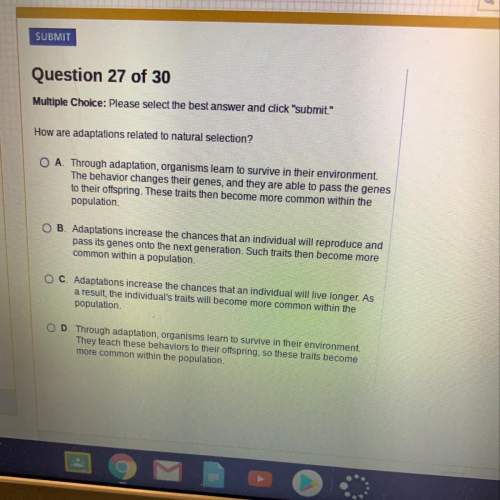
Biology, 22.04.2020 00:06 stephaniedoffing
A researcher who detects a higher-than-normal amount of interferon in a laboratory rat would correctly conclude that a. the rat has, or recently had, a viral infection. b. cancerous cells are present in the rat. c. the rat's diet is deficient in calcium. d.monocytes are differentiation into macrophages in the rat's bloodstream.

Answers: 1


Other questions on the subject: Biology

Biology, 22.06.2019 07:30, tamerrapittsoy4ii6
Pls need ! in your opinion, what are the limiting factors that might affect the growth or diversity of our ecosystem? respond to this question in claim, evidence, reasoning format. 1. make your claim (i are the limiting factors that might affect the growth or diversity of our 2. follow the claim with 3 pieces of evidence. evidence may be taken from the reading, the videos, previous lessons, or googled answers. site sources, too. 3. use reasoning to explain why you chose your evidence.
Answers: 2

Biology, 22.06.2019 08:00, friskisthebest1
As the pea seeds respire, the level of coloured liquid in the left hand part of the capillary tube rises. by referring to what is happening in the apparatus, explain why the level of liquid changes
Answers: 3


Biology, 22.06.2019 17:30, xman839
98 points you will be galileo perform the experiment to determine if objects with different mass fall at the same, or different, rates in the air and in a vacuum. before you conduct your experiment, you need to form a hypothesis. a hypothesis is a prediction of what you think will happen in the experiment. the hypothesis is a statement that describes “if” a certain set of circumstances are present “then” there will be a specific result that will occur. record your hypothesis here: record the results from step one of the experiment (dropping the objects in the air): first trial: second trial: third trial: record the results from step two of the experiment (dropping the objects in a vacuum): first trial: second trial: third trial: did the experiment support your hypothesis? using the data from your experiment, describe why you believe your hypothesis was either proven or disproven. what forces were acting on the objects dropped in the air? what force was acting on the objects dropped in the vacuum? part two: comparing forces choose two forces and compare and contrast these forces. you must provide two ways that they are alike and two ways that they are different. you may make a list, write in paragraph form, or make a chart. choose two forces and compare and contrast these forces. these must be different forces than used in the prior question. provide two ways that they are similar and two ways that they are different. you may make a list, write it out, or make a chart.
Answers: 1
You know the right answer?
A researcher who detects a higher-than-normal amount of interferon in a laboratory rat would correct...
Questions in other subjects:

History, 22.05.2020 18:00

Biology, 22.05.2020 18:00

English, 22.05.2020 18:00

Mathematics, 22.05.2020 18:00



Mathematics, 22.05.2020 18:00






